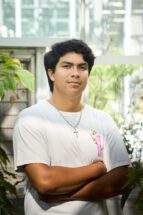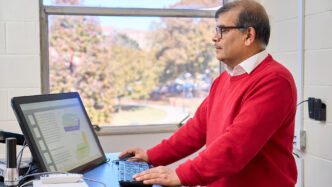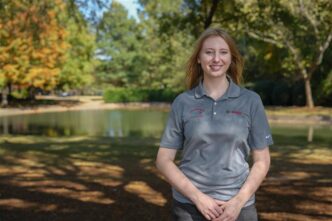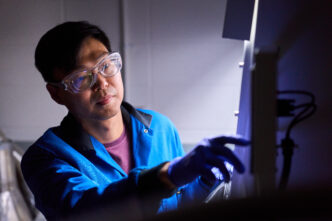At first glance, the connection between wanting to pursue a career as a surgeon and conducting research on the rooting ability of yellow camellias may be difficult to see.
But Clemson University senior Allen Gomez says the research he has done through the Creative Inquiry + Undergraduate Research program gives him valuable research experience to bolster his medical school applications and allows him to hone skills he’ll use throughout his career in medicine.

Gomez chose the yellow camellia CI project in the lab of Haiying Liang, an associate professor in the Department of Genetics and Biochemistry whose research focuses on the application of genetics and genomics to improve economically important traits in plants, because of his interest in genetics.
“I think it’s really interesting how gene editing and being able to modify and improve certain aspects of different organisms through genetics works,” said Gomez, who is majoring in biochemistry and minoring in genetics and chemistry.
His CI project, conducted under the direction of first-year Ph.D. student, Roger Zhang, investigated the expression levels of auxin response factor (ARF) genes in Camellia nitidissima. ARF genes have been studied in Arabidopsis, a model plant in the mustard family, and shown to be related to rooting formation. The project aimed to determine how ARF genes were regulated in yellow camellias.
Gomez helped assemble a yellow camellia transcriptome and conduct a Basic Local Alignment Search Tool (BLAST) search against the assembled transcriptome using the ARF genes from Arabidopsis as the queries. Primers — short stretches of DNA that target unique sequences and help identify part of the genome — were designed for the specific genes in yellow camillias related to ARF genes. Gomez ran polymerase chain reaction (PCR) and quantitative PCRs to detect the expression levels of these genes in different tissue types, including leaf, root, stem and flower at four different times after rooting.

The research could determine a method to induce adventitious roots and develop a treatment method that would improve the rooting ability of yellow camellias.
Yellow camellias are far rarer than white, pink and red. Truly yellow flowers are found only in south China and Vietnam. Yellow camellias are commercially available from only two nurseries in the United States, Liang said. The research aims to make propagation — and growing — of yellow camellias easier.
Gomez, who will continue to work in the lab during this academic year, said the skills he’s learning in the lab are transferable.
“It shows that I am able to follow instructions step-by-step, take precise notes, solve problems, work with others, interpret data and know the importance of sterility. I’ll use those skills in medical school and as a surgeon,” he said.
Gomez’s desire to become a surgeon stems from a childhood experience.
Gomez was 10 years old when his family moved to Ecuador. One day while playing, he fell off some monkey bars and broke his wrist. Because he lived in a remote area, it was four days before he could get the surgery he needed. That sparked his interest in surgery and a desire to help bring more medical services to rural areas in Ecuador.
He said his experiences at Clemson helped solidify his belief that pursuing a medical career is the right thing to do.







